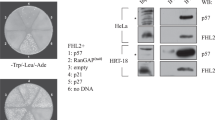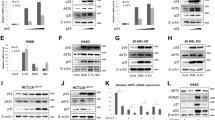Abstract
p53 has a role in many cellular processes through the transcriptional regulation of target genes1,2. PAC1 (phosphatase of activated cells 1; also known as dual specificity phosphatase 2, DUSP2) is a dual threonine/tyrosine phosphatase that specifically dephosphorylates and inactivates mitogen-activated protein (MAP) kinases3,4. Here we show that during apoptosis, p53 activates transcription of PAC1 by binding to a palindromic site in the PAC1 promoter. PAC1 transcription is induced in response to serum deprivation and oxidative stress, which results in p53-dependent apoptosis, but not in response to γ-irradiation, which causes cell cycle arrest5,6. Reduction of PAC1 transcription using small interfering RNA inhibits p53-mediated apoptosis, whereas overexpression of PAC1 increases susceptibility to apoptosis and suppresses tumour formation. Moreover, activation of p53 significantly inhibits MAP kinase activity. We conclude that, under specific stress conditions, p53 regulates transcription of PAC1 through a new p53-binding site, and that PAC1 is necessary and sufficient for p53-mediated apoptosis. Identification of a palindromic motif as a p53-binding site may reveal a novel mechanism whereby p53 regulates its target genes.
This is a preview of subscription content, access via your institution
Access options
Subscribe to this journal
Receive 51 print issues and online access
$199.00 per year
only $3.90 per issue
Buy this article
- Purchase on Springer Link
- Instant access to full article PDF
Prices may be subject to local taxes which are calculated during checkout




Similar content being viewed by others
References
Levine, A. J. p53, the cellular gatekeeper for growth and division. Cell 88, 323–331 (1997)
Vogelstein, B., Lane, D. & Levine, A. J. Surfing the p53 network. Nature 408, 307–310 (2000)
Rohan, P. J. et al. PAC-1: a mitogen-induced nuclear protein tyrosine phosphatase. Science 259, 1763–1766 (1993)
Ward, Y. et al. Control of MAP kinase activation by the mitogen-induced threonine/tyrosine phosphatase PAC1. Nature 367, 651–654 (1994)
Kastan, M. B. et al. A mammalian cell cycle checkpoint pathway utilizing p53 and GADD45 is defective in ataxia-telangiectasia. Cell 71, 587–597 (1992)
Brugarolas, J. et al. Radiation-induced cell cycle arrest compromised by p21 deficiency. Nature 377, 552–557 (1995)
Zhao, R. et al. Analysis of p53-regulated gene expression patterns using oligonucleotide arrays. Genes Dev. 14, 981–993 (2000)
Nishida, E. & Gotoh, Y. The MAP kinase cascade is essential for diverse signal transduction pathways. Trends Biochem. Sci. 18, 128–131 (1993)
Shaw, P. et al. Induction of apoptosis by wild-type p53 in a human colon tumour-derived cell line. Proc. Natl Acad. Sci. USA 89, 4495–4499 (1992)
Yin, Y., Solomon, G., Deng, C. & Barrett, J. C. Differential regulation of p21 by p53 and Rb in cellular response to oxidative stress. Mol. Carcinog. 24, 15–24 (1999)
El Deiry, W. S., Kern, S. E., Pietenpol, J. A., Kinzler, K. W. & Vogelstein, B. Definition of a consensus binding site for p53. Nature Genet 1, 45–49 (1992)
Baker, S. J., Markowitz, S., Fearon, E. R., Willson, J. K. & Vogelstein, B. Suppression of human colorectal carcinoma cell growth by wild-type p53. Science 249, 912–915 (1990)
Foord, O. S., Bhattacharya, P., Reich, Z. & Rotter, V. A DNA binding domain is contained in the C-terminus of wild type p53 protein. Nucleic Acids Res. 19, 5191–5198 (1991)
Gu, W. & Roeder, R. G. Activation of p53 sequence-specific DNA binding by acetylation of the p53 C-terminal domain. Cell 90, 595–606 (1997)
El-Deiry, W. S. et al. Topological control of p21WAF1/CIP1 expression in normal and neoplastic tissues. Cancer Res. 55, 2910–2919 (1995)
Fire, A. et al. Potent and specific genetic interference by double-stranded RNA in Caenorhabditis elegans. Nature 391, 806–811 (1998)
Suit, G. et al. A DNA vector-based RNAi technology to suppress gene expression in mammalian cells. Proc. Natl Acad. Sci. USA 99, 5515–5520 (2002)
Almasan, A. et al. Deficiency of retinoblastoma protein leads to inappropriate S-phase entry, activation of E2F-responsive genes, and apoptosis. Proc. Natl Acad. Sci. USA 92, 5436–5440 (1995)
Yin, Y. et al. Involvement of p85 in p53-dependent apoptotic response to oxidative stress. Nature 391, 707–710 (1998)
Maiyar, A. C., Huang, A. J., Phu, P. T., Cha, H. H. & Firestone, G. L. p53 stimulates promoter activity of the sgk. serum/glucocorticoid-inducible serine/threonine protein kinase gene in rodent mammary epithelial cells. J. Biol. Chem. 271, 12414–12422 (1996)
Minden, A. et al. c-Jun N-terminal phosphorylation correlates with activation of the JNK subgroup but not the ERK subgroup of mitogen-activated protein kinases. Mol. Cell. Biol. 14, 6683–6688 (1994)
Acknowledgements
We thank A. J. Levine for advice on promoter studies and for providing critical reagents, and W. Gu for the pCMV-p53Δ270 plasmid. We are grateful to H. B. Lieberman for critical reading of the manuscript. We also thank T. A. Sato for help with the luciferase assay. This work was supported by a start up fund from the Columbia University (Y.Y.) and NIH grants (to Y.Y. and E.J.H).
Author information
Authors and Affiliations
Corresponding author
Ethics declarations
Competing interests
The authors declare that they have no competing financial interests.
Supplementary information
Rights and permissions
About this article
Cite this article
Yin, Y., Liu, YX., Jin, Y. et al. PAC1 phosphatase is a transcription target of p53 in signalling apoptosis and growth suppression. Nature 422, 527–531 (2003). https://doi.org/10.1038/nature01519
Received:
Accepted:
Issue Date:
DOI: https://doi.org/10.1038/nature01519
This article is cited by
-
Novel targets for immunotherapy associated with exhausted CD8 + T cells in cancer
Journal of Cancer Research and Clinical Oncology (2023)
-
Dual-specificity phosphatases: therapeutic targets in cancer therapy resistance
Journal of Cancer Research and Clinical Oncology (2022)
-
The p53 status in rheumatoid arthritis with focus on fibroblast-like synoviocytes
Immunologic Research (2021)
-
Protein tyrosine phosphatases: promising targets in pancreatic ductal adenocarcinoma
Cellular and Molecular Life Sciences (2019)
-
RCC2 is a novel p53 target in suppressing metastasis
Oncogene (2018)
Comments
By submitting a comment you agree to abide by our Terms and Community Guidelines. If you find something abusive or that does not comply with our terms or guidelines please flag it as inappropriate.



